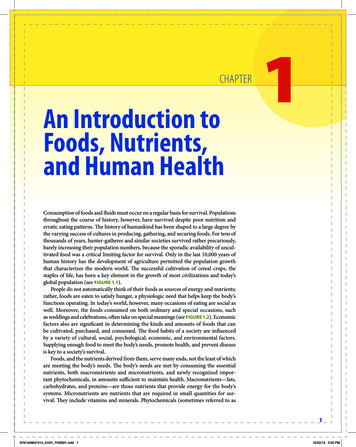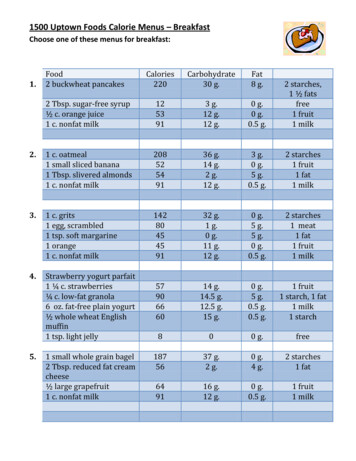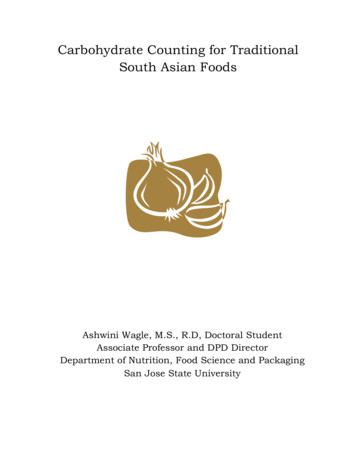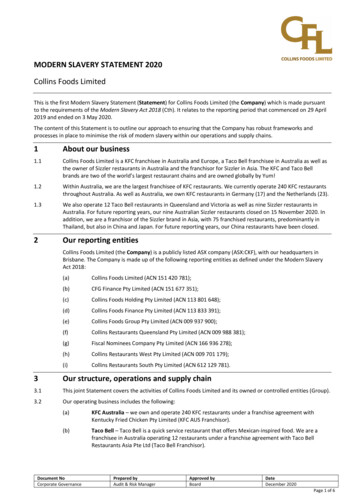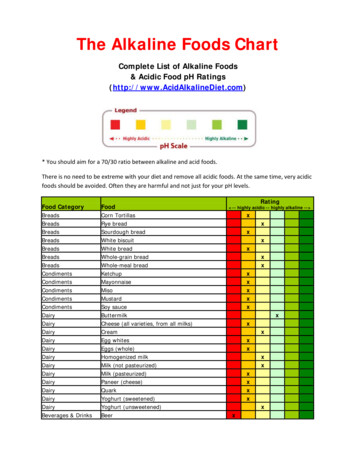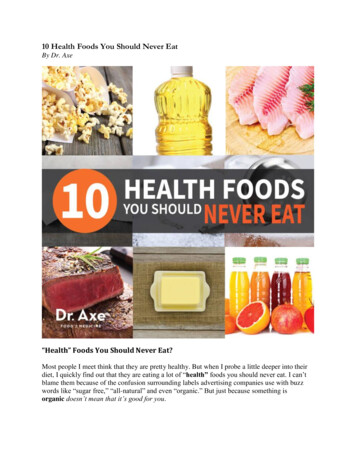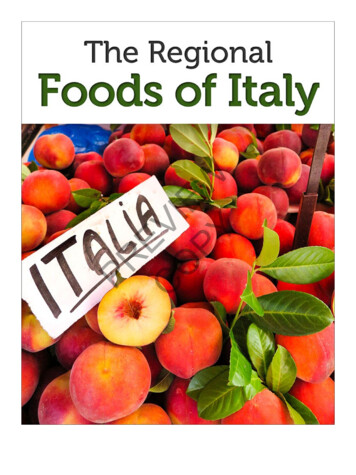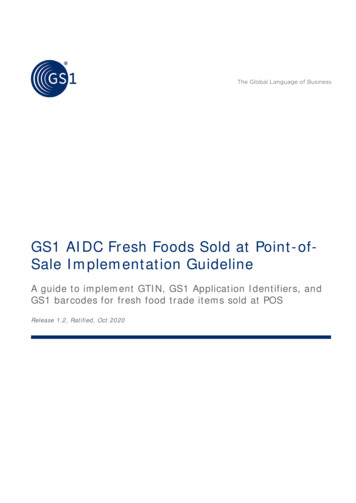
Transcription
VOl. I 2Unusual foods for human consumption69these foods are considered a delicacy by the Isoko. Palm weevils, the larvas ofRhynchophorusphoenicis, which inhabit the boles of the red-oil palm, are eaten afterroasting over an open fire. From personal experience they are very palatable toanyone who enjoys a ' palm-oil stew '.Snakes of various species and the monitor lizard are also eaten by Isoko farmerswhen the opportunity arises. T h e whole of this tasty, if somewhat unusual, dietis washed down on high days and holidays by copious draughts of palm wine, whichhas been fermented for a number of days. This wine induces the stimulation, followed by sedation, that the Isoko consider essential to full enjoyment of a lifepursued under anxious circumstances in an out of the way part of the world.REFERENCENicol, B. M. (1952). Brit. J. Nutr. 6, 34.The Diet of Canadian Indians and EskimosBy H. M. SINCLAIR,Laboratory of Human Nutrition,University of OxfordApart from racial differences, the Eskimos are unlike the Northern Indians inthree respects that concern us. First, the typical Eskimos live on the coast andobtain most of their food from the sea, whereas the Indians live inland. Secondly,the Eskimos frequently eat their food raw whereas this disgusts the Indians whoindeed named the Eskimos after this habit : the Cree word uskipoo means ' heeats raw meat '. Thirdly, the Eskimos live mainly north of the tree line, andalthough they collect some driftwood for sledges and boats they have to dependmainly upon animals, snow and rock for their houses, implements, boats, fuel andclothing ; the Indians have access to wood.The foodstufls of the Eskimos(cf. Amundsen, 1908 ; Birket-Smith, 1936, 1947 ; Egede, 1818 ; Eisberg &Owens, 1949 ; Forde, 1939 ; Hanson, 1942 ; Karavayeva, 1938 ; Rasmussen,1927 ; Stefinsson, 1913, 1914, 1922, 1939 b, c, 1945, 1946 ; Winn, 1943 ; Yule,1948.)Winter. Characteristic hunting is found amongst the Iglulik, Central Eskimosliving north of Hudson Bay and in the north of Baffin Land, between latitudes 65'to 75"N. T h e long Arctic winter with a mean temperature of around -335OF. andshort daylight hours limits activity ; thick mists are usual unless dispersed by strongwinds which, uninterrupted by trees, cause violent blizzards. As winter beginsto set in the Eskimos congregate on the coast or floe ice. T h e main food throughout the winter is the seal. These animals scratch breathing-holes in the floe in theautumn and maintain them throughout the winter. T h e Eskimo dog scents thembeneath the snow and if they are in use the hunter will fix a piece of bone in thehole which will be disturbed when the seal pushes up its nose to breathe ; then heDownloaded from https://www.cambridge.org/core. Loyola Notre Dame, on 14 Feb 2022 at 04:40:02, subject to the Cambridge Core terms of use, available athttps://www.cambridge.org/core/terms. https://doi.org/10.1079/PNS19530016
70SYMPOSIUMPROCEEDINGSI953thrusts his harpoon down the hole, plays the seal until it tires, and then enlargesthe hole and drags the animal home. This is the so-called ma'upoq (waiting)hunting-a severe ordeal since the hunter sits absolutely still on a block of snow inthe raw cold of the short winter day without having had a meal. Blizzards or fogmay prevent hunting for days and, since it is difficult to obtain sufficient seal to lastmore than a few days, severe shortage of food is common in winter. T h e seal isthe most important animal to the Eskimo, although according to Stefhnsson (1921)it is the most difficult of all north polar animals to get. T h e two seal mainly huntedfrom the Bering Strait to northern Greenland are the ringed seal (Phoca foetida)and the barbed seal (Erignathus barbatus). Other seals (such as Cystophora cristataand Phoca groenlandica in the Atlantic, and Arctocephahs ursinus, Histriophocafasciata and Eumetopias jubatus off Alaska) avoid firm ice and so only approachthe shore periodically. T h e seal provides large quantities of superb fuel for lightingor heating (a 200 lb. seal provides nearly IOO lb. of blubber in winter) ; it is excellent food for men and dogs ; its skin is used for boats, clothing and containers foroil ; its sinews are used for thread ; and the intestines are used for clothing andwindows. T h e Eskimo eats most parts of the seal including the blood ; theblubber is not eaten in large amount except in emergencies. T h e meat, which isvery dark, is particularly relished ; it looks extremely lean but according to analysesof I;. G. Benedict contains 6-10% fat (Krogh & Krogh, 1914),though Rabinowitch& Smith (1936) found less.I n Hudson Bay, far far awayFrom Simpson's choicest torso,You can get a meal from an Elephant seal,As pleasant if not more so (Anonymous, not dated).Spring. T h e walrus (Odobenus rosmarus in the east and 0. obesus in the BeringSea region), belonging to the same suborder as the seal (Pinnepedia), has somewhatdifferent dietary habits. Whereas the seal eats fish, crustacea, molluscs and evenbirds, the walrus unearths with its enormous canines the crustacea and molluscsthat live on the bottom. Walruses are not hunted until spring when leads of openwater appear and the light skin-covered canoe (Kayak) is used to harpoon walrusesand occasional whales. T h e contents of the stomach of the walrus are regardedas a delicacy, particularly when they contain the feet of the bivalve Cardium,aroenZandicum (Vibe, 1950). T h e spring is also a great time for Ctoq (stalking)hunting of seals which gather in numbers on the edge of the floes before these breakup, and lie basking with their young. At this time of abundance of food, largeamounts of blubber are stored in hide bags in pits on the shore beneath rock cairnsto protect them from wolverines and foxes. Other animals are hunted in thespring. T h e polar bear (ThaZarctos maritimus), which comes in from the packice to eat young seals, is hunted with dog-sledges and brought to bay by releasingthe dogs ; its liver is eaten by neither Eskimo nor dog because it is toxic, apparentlybecause of its richness in vitamin A (Rodahl & Moore, 1943 ; Rodahl, 1949).Downloaded from https://www.cambridge.org/core. Loyola Notre Dame, on 14 Feb 2022 at 04:40:02, subject to the Cambridge Core terms of use, available athttps://www.cambridge.org/core/terms. https://doi.org/10.1079/PNS19530016
VOl.I2Unusual foods foy human consumption71The musk OX (Ovibos moschatus) used to be very common, but has rapidly decreasedin numbers and become rare or extinct in some areas such as Banks Island whereit grazed in large numbers at the beginning of the century. The Canadian Government has banned hunting of the oxen. They are docile, clumsy and slow, and theherd could easily be rounded up and kept at bay by dogs so that the Eskimos,who relish the meat, could kill them with spears. Their rarity is caused by theease with which they are shot, and the practice of killing the whole herd,Summer. With the arrival of summer, the dietary changes. Vegetation sprouts,and the Eskimo moves inland to hunt land animals, particularly the caribou(Rangifer arcticus). T h e herds of these migrate northward at this season takingyear by year the same route, and the Eskimos congregate together to drive them intoambushes or marshy ground, or particularly into water where they can be lancedfrom a kayak as they swim. Unlike the musk oxen, which eat grass, caribou eatmainly mosses and lichens ; they provide meat and some fat. The Eskimos arevery fond of the fermented and rather sour contents of the caribou paunch ; theyalso eat the faeces either directly or in soup. Other land animals are eaten at thisseason. Wolves are killed with a sharpened strip of baleen rolled in frozen blubberand hares are snared, and the large summer flocks of birds such as duck and geesewhich migrate northwards are speared or noosed. Fishing, particularly for salmon(such as Mallotus villosus), is important ; they are usually speared, but sometimesnetted or caught on hooks with ivory minnows as bait. In summer the Eskimoceases to be a strict carnivore. Some berries are eaten : the commonest areblack crowberry (Empetrum nigrum var. hermaphroditum), dwarf blueberry (Vaccinium uliginosum var. alpinum), and cloudberry (Rubus chamaemorus). Certainroots (such as Polygonurn viviparurn), the stalk of the aromatic angelica (Angelicaarchangelica), some algae, and also the buds and young leaves of the dwarf willow(Salix arctica) are eaten in small amounts. Some berries and leaves (such asCochlearia ofJicinalis, Oxyria digyna and Epilobium latifoliurn) are stored for thewinter, but in general the consumption is not large.Geographical variations. Such is the characteristic dietary pattern of the typicalEskimo. Variations will depend upon locality. T h e Eastern Eskimos -of Greenland and the Western Eskimos from the Mackenzie river to the eastern tip of Siberiahunt seals using the kayak and whales with the kayak or umiak. The most important item of food of the Polar Eskimos is the narwhal (Monodon monoceros). Itfeeds mainly on polar cod (Gadus saida), Greenland halibut (Rheinhardtius hippoglossoides) and large numbers of shrimps (Decapoda). It is hunted almost exclusively from the kayak, and according to Vibe (1950)' T h e whole existence of the PolarEskimos depends on the catch of this animal, since they get all their necessariesof life from it '. T h e skin (mattak) is greatly relished and tastes like hazel-nuts ;it is eaten raw and contains considerable amounts of glycogen and ascorbic acid.The White whale (Delphinupterus leucas) is almost as important, but it is more shyand much harder to catch ; its diet is similar except that it does not consume decapods. Ice-hunting as I have described above is mainly practised by the CentralEskimo. The Caribou Eskimo, for instance the Ihalmiut very recently describedDownloaded from https://www.cambridge.org/core. Loyola Notre Dame, on 14 Feb 2022 at 04:40:02, subject to the Cambridge Core terms of use, available athttps://www.cambridge.org/core/terms. https://doi.org/10.1079/PNS19530016
72SYMPOSIUMPROCEEDINGSI953by Mowat (1952),live inland and so depend almost entirely during the winter oncaribou meat obtained as the herds migrate southwards in autumn, and kept frozenor dried. For any true Eskimo the winter is likely to be a period of privation. Butmany Eskimos, like the Indians to be mentioned shortly, have become contaminatedby white traders or missionaries, and supplied with white flour, sugar and tea.Preparation of food. As already mentioned, the Eskimos often eat their foodraw, sometimes frozen, sometimes thawed. Cooking when done consists of boiling or occasionally roasting, never frying. Caribou meat and fish are eaten raw,and are preferred when they are rotten ; caribou and fish heads are boiled. Thecaribou liver is allowed to ferment inside the moss-filled caribou stomach undera hot sun for some days before being eaten ; probably all its glycogen breaks down.Seal is lightly boiled over a lamp of seal oil, blood being added to make soup afterthe cooked meat has been taken from the pot ; if eaten raw, seal is eaten frozen.Dried meat with fat may be pounded into pemmican ; this foodstuff has beenpraised by Stefbnsson (1944)but was found very unsatisfactory by his colleagueHadley (Stefbnsson, 1921)and by others (cf. Kark, Johnson & Lewis, 1945).Large quantities of water are drunk during a meal which, like most aspects ofEskimo life, is unhygienic-face, hands and clothing get smeared with fat and gravy,and those eating do not necessarily leave the meal to urinate. Food is distributedfrom the common dish to all present, usually in a definite order ; but there are anumber of food taboos particularly concerning the young. The evil of not sharingthe catch with those too old or young or ill to hunt is illustrated by the widespreadfolklore tale of the boy who hunted at frozen-up breathing-holes (Holtved, 1951):a feeble old woman and her young grandson were being left out of the commondistribution of the short supply of food and began to starve ; the old woman triedto catch food around the hut, but caught nothing except the refuse that lies thickin the snow. So she made a harpoon for the boy and asked the hunters to lead himto a frozen-up (and therefore unused) breathing-hole. T h e boy sat there knowingno better, but suddenly an enormous seal broke through the ice to breathe. Hespeared it and with the help of the old woman brought it home and ate it. Theothers caught nothing. Thereafter the boy and the old woman had regular catcheswhich they rightly did not share with the others, who continued to catch nothingand starved to death.'The nutritional value of the Eskimo dietIn 1855 Rink (1857, 1877) made a statistical study of the annual food consumption of the 6100 Eskimos in the Southern Inspectorate of Greenland. This district was south of the area of dog sledges, and since there were no domesticatedanimals it was easier to estimate how much of the indigenous food resources wasconsumed by man. Rink estimated that about 40% of the Eskimos were below15 years of age and 0.3% above 60 years ; 48% were males and 52% females.The main foodstuff was seal meat and the next most important was the capelin(Mullotus willosus) ; this small salmon visits the shores of Greenland in large shoalsin July and is dried whole and stored. Some berries (Vuccinium uliginosum) andDownloaded from https://www.cambridge.org/core. Loyola Notre Dame, on 14 Feb 2022 at 04:40:02, subject to the Cambridge Core terms of use, available athttps://www.cambridge.org/core/terms. https://doi.org/10.1079/PNS19530016
VOl.I2Unusual foods for human consumption73unknown quantities of mussels, seaweed and angelica were included in the ‘ native ’diet which was supplemented with bread and flour, barley and peas, sugar andcoffee bought from Europeans. Krogh & Krogh (1914)took this population ascorresponding to 5000 adults, and estimated thereby the daily food consumptionof an adult. Guessing a factor for wastage and using analyses partly done for themby F. G. Benedict, they then calculated the aliments and calories in the daily diet :Protein (g)Carbohydrate (g)Fat (g)Calories (Cal.)28254I352640As Krogh & Krogh pointed out, the figures could ‘ easily be 10% and possiblyeven 20% wrong or more ’ ; the factor for wastage in preparation and storage wasparticularly doubtful. For instance they assumed a loss of 50% in capelins,which are eaten whole-heads, bones and skin-since ‘ a considerable part is nodoubt lost during the time they are kept in a preserved state ’. It is difficult tosee what they lose ; the dried fish kept in a cache under the snow may well retaina considerable amount even of their ascorbic acid.It is worth extending the analysis of Rink‘s (1857) figures further with the grosserrors fully in mind. The estimation of ‘ food moving into civilian consumption ’is not a method by which nutriture can be assessed (Sinclair, 1948 ); and in mostinstances no suitable food analyses are available even for fresh foods. The Eskimos eat seal meat lightly boiled usually in sea water ; there may be only trivial lossof ascorbic acid and unknown dietary additions of calcium and other salts (ofcourse no sodium chloride as such is added to the diet). Meat and fish are frequently eaten raw and after considerable putrefaction ; eggs are eaten raw at any stageof incubation : no guess is profitable about the effect on vitamins of the B complex but it is certain that much of the glycogen, which has usually been taken torepresent about half the total dietary carbohydrate (Krogh & Krogh, 1914),willhave broken down, but the products are presumably used. On the other hand,when a seal is caught the liver is often eaten quickly ; in the calculations belowno account has been taken of the viscera of the seal that are eaten except for vitaminA (seal liver contains 75,000 i.u. and seal oil 7000 i.u./Ioo g (Heller, 1949)) ; thezero figure for vitamin D in the seal as eaten given in Table I is obviously wrong.But it is preferable that guesses should err by being underestimates. With thesegross limitations in mind therefore, an estimate of the nutritional value of thedietary of an adult Eskimo living in the Southern Inspectorate of Greenland in1855 may be made (Table I). The table gives for purposes of comparison thestandards of the Oxford Nutrition Survey for a moderately active man (Sinclair,1948b); Table 2 gives the modern per capita consumption of aliments by Greenlanders (Bertelsen, 1935-43)when about 65% of the food is imported from Europe.Little comment is needed. Carotenoids are of course irrelevant since the ingestionof vitamin A is so high. The figure for calcium is a gross underestimate since noDownloaded from https://www.cambridge.org/core. Loyola Notre Dame, on 14 Feb 2022 at 04:40:02, subject to the Cambridge Core terms of use, available athttps://www.cambridge.org/core/terms. https://doi.org/10.1079/PNS19530016
Downloaded from https://www.cambridge.org/core. Loyola Notre Dame, on 14 Feb 2022 at 04:40:02, subject to the Cambridge Core terms of use, available athttps://www.cambridge.org/core/terms. https://doi.org/10.1079/PNS19530016Oxford NutritionSurvey standardProportion of standard met (%)Seal fleshOther fleshCapelin (salmon)Other fishEggsBerriesBreadBarley and peasSugarCoffeeTotalFoodstuffI.IIZ30001021040514 159 40536 43237359 16220-3I600354750441100012442833 30003074zoo57 6147ooI009401 4407 23300.1Io03I26 1037 27o19o1106110.543163524 1036721686 163441 43620645 o02.64 19500020.010.020-020.870.180.321.2(w) (mdAs-NicotiniccorbicacidRiboflavin acid(a) (md0.95 42.1oo02511.0ooo 61441-30 46.1oo8.50.15(vdCaI- Phos- Vitamin Carocium phorusAtenoids(a)(mp) (mg) ( i . 423.295 1686 77406-1 25 4 4 1 20256.2 155 I5005083.367 69956IronNutritional value of the adult Eskimo daily diet in 1855Wt. ofTotalCarboediblepro- Animal hyportion Calories tein protein drate Fat(9)(Gal.)(9)(8)(g)(9)TableP
VOl.Unusual foodsI2Table2.foy75human consumptionModern per capita consumption ( g ) of aliments daily by Greenlanders(Bertelsen, igenousTotalImportedIndigenousTotalProtein 73563allowance has been made for sea water consumed or for the bones eaten ; the figurefor vitamin D (overestimated probably in fish but underestimated in meat) is veryhigh. Little of the iron ingested is absorbed : seal meat is almost black probablybecause of a high content of myoglobin ; so are the Eskimo faeces which are easilyinspected around their huts. Ascorbic acid is high : though the berries are oftenswallowed whole and pass through the gut unaltered and though raw meat has oftendecomposed, the practices of eating raw the flesh, skin and viscera of animals thathave a high content of ascorbic acid (Bertelsen, 1911 ; Haygaard & Rasmussen,1939 ; Anonymous, 1950) and of eating the moss and lichens in the acid contentsof the caribou pouch (though these are often fermented) must provide considerableamounts of ascorbic acid ; further, no allowance has been made for sea algae whichcontain 10-50 mg/Ioo g (Hoygaard, 1938). We may cheerfully conclude that therewas an abundance of nutrients in the Eskimo dietary of a century ago, and passto consider further the aliments.The requirement of the Eskimo for aliments is obviously increased by his coldenvironment : he has no heating in his hut except for that derived from cookingand lighting ; his heat loss is diminished by his relatively low surface area, by hislayer of subcutaneous fat and by his efficient clothing. But he loses a considerableamount of heat with each breath he takes. Heat is required for warming and forhumidifying inspired air, and the amount is large : a man whose energy metabolismis 3000 Cal. daily exclusive of that necessary to warm and humidify the inspiredair would require an expenditure of 4073 Cal. daily at an average temperature of-40 F. (Webster, 1947). The consumption of a meal of frozen meat incurs a lossof heat : 4 kg of meat at -40 F. eaten in a day adds about 300 Cal. to the dailyenergy expenditure. His activity is difficult to estimate : hunting and travellingmay be strenuous, but a good deal of time is spent eating, sleeping or sitting. Hisbasal metabolic rate has interested a number of people. Some (e.g. Levine, 1949)have pronounced it normal ; others (e.g. Brown, 1951)have found it increased :Rabinowitch & Smith (1936) found the average increase in ten Eskimos26%,and this they attributed to increased muscle tone and the specific dynamic actionof protein (Krogh & Krogh (1914) thought the specific dynamic action was remarkably low in the Eskimos they studied). There is in fact nothing unusual aboutthe total intake of aliments ; it is the very high protein, very low carbohydrate and Downloaded from https://www.cambridge.org/core. Loyola Notre Dame, on 14 Feb 2022 at 04:40:02, subject to the Cambridge Core terms of use, available athttps://www.cambridge.org/core/terms. https://doi.org/10.1079/PNS19530016
76SYMPOSIUMPROCEEDINGSI953highfat intakes that have excited interest. It is, however, worth noting that according to the customary convention (Woodyatt, 1921 ; Shaffer, 1921) this diet is notketogenic since the ratio of ketogenic(FA) to ketolytic (G) aliments is 1.09. Indeed,the content of fat would have to be exactly doubled (324 g daily) to make the dietketogenic (FA/G 1-5).The Eskimo is apparently able to digest and absorb very large amounts of protein and fat at a single meal. In times of plenty, 4 kg of meat daily is a commonamount and much is taken at a single meal : they do not usually take food in themorning. Consumption of larger amounts such as 1 5 kg has been observed onoccasion, and Ross (1835) considered that an Eskimo ' perhaps eats twenty poundsof flesh and oil daily', which I suppose is possibly 46,000 Cal. Parry (1824)thoughthe would test the capacity of an adolescent Eskimo ; the food was weighed and,apart from fluids, he ate in 20 h 84 lb. meat and 12 lb. bread (about 15,700 Cal.)and ' did not consider the quantity extraordinary '. But this is trivial comparedwith the feats of the Siberian Yakuti who eat 25-30 lb. meat daily, and there is norecord approaching the 35 lb. of beef and 18 lb. of butter (providing about 112,000Cal. and occupying a volume of the order of 54 gal.) alleged to have been eaten inless than 3 h by each of two Yakuti (Simpson, 1847.)Eskimo metabolism, nutriture and health(cf. Alexander, 1949 ; Barnett, Fields, Milles, Silverstein & Bernstein, 1947 ;Bermudez, 1950 ; Brown, Sinclair, Cronk & Clark, 1948 ; Brown, Sinclair, Cronk& deSinner, 1 9 4 9 ; Crile & Quiring, 1939 ; Ehrstrom, 195oa, c ; Hatcher, Page& Brown, 1950 ; Heinbecker, 1928, 1932-3 ; Higgins, Peabody & Fitz, 1916 ;Levine, 1942 ; Lieb, 1926 ; Lockhart, 1945 ; McCann, 1950 ; McClellan &Du Bois, 1930 ; Mould, 1940 ; Payne & Sexton, 1949 ; Pedersen, 1947 ; Roberts,1943 ; Rodahl & Edwards, I952 ; Sinclair, Brown, Cronk & Clark, 1948 ; Sinclair,Brown, Cronk & deSinner, 1949 ; Stefhnsson, 1918, 1939a ; Thomas, 1927 ;Urquhart, 1935 ; Waagstein, 1951 ; Waugh,1933 ; Wells, 1933 ; Wells &Heinbecker, 1932 ; Wilson, 1945.)The high ingestion of protein alters blood and urinary composition : nonprotein nitrogen and amino-acids are raised in plasma, and urinary nitrogen is increased (Rabinowitch & Smith, 1936), even during fasting (Heinbecker, 193I ) ;plasma protein has been found to be normal by all observers. The fairly highingestion of fat appears to raise somewhat the lipid constituents of the blood (Sinclair,Brown & Cronk, 1949), although the results are not consistent : Corcoran &Rabinowitch (1937) made claims that do not appear to be supported by a statisticalanalysis of the figures they give (which is not assisted by errors in their table of meansif the individual figures they give are correct) ; Wilber & Levine (1950) claimedhigher values than normal but did not state the age of their subjects ; Brown (195I )found normal values. The main interest of these lies in the cholesterol. Keys andothers have shown that increased fat in the diet tends to increase cholesterol inserum (Keys, 1952 ; Keys, Mickelsen, Miller & Chapman, 1950 ; Hildreth, Mellinkoff, Blair & Hildreth, 1951), and therefore probably to increase the incidenceDownloaded from https://www.cambridge.org/core. Loyola Notre Dame, on 14 Feb 2022 at 04:40:02, subject to the Cambridge Core terms of use, available athttps://www.cambridge.org/core/terms. https://doi.org/10.1079/PNS19530016
VOl.12Unusual foods for human consumption77of arteriosclerosis ; Tolstoi (1929) claimed lipaemia and increased cholestrol intwo men who lived for I year on lean and fat meat, but an inspection of his figuresshows that there was in fact no increase in cholesterol in one of the two. Fromthe scanty data available, it appears that the true Eskimos consume an unusuallyhigh quantity of fat but that their serum total cholesterol is normal (cf. Garn &Gertler, 1951) ; the matter requires further investigation. Corcoran & Rabinowitch (1937) concluded that meat-eating Eskimos had a very active and unusualmechanism for utilization of fats ; part of their evidence was that the ratio ofphospholipids to total cholesterol rose in two subjects after ingestion of zoo ml. ofsoya-bean oil, but this is not in accord with the figures they give. To the unusualmechanism they attributed the absence of ketosis in the Eskimo. Tolstoi’s (1929)two men had ketonuria over the entire period of the experiment, despite the C0,combining power of plasma remaining within normal limits ; these men of coursewere not Eskimos. The serum lipids increased in four Eskimos in SouthamptonIsland who subsisted for 6 days exclusively on pemmican (75% of calories fromfat), and increased further when they fasted ; ketonuria developed during the fastonly (Sinclair, Brown & Cronk, 1949). The ketonuria of U.S. soldiers in theArctic on normal rations has been attributed to the general adaptation syndrome(Kark, Johnson, Bly & Consolazio, 1949 ; Sargent & Consolazio, 1951).We may conclude from the above that, provided the Eskimo can catch his normalsources of food, his diet is adequate ; when the animals are scarce or conditionssuch as fog prevent hunting he often starves. It is generally agreed that ricketsand scurvy are unknown, the former despite the meagre sunlight and pigmentationof the skin. Brown (1951) states that the most frequently occurring clinical signsin the Eskimo population as a whole were ascorbic acid deficiency and riboflavindeficiency’, but these signs are not specific and strong exception can be taken to thestatement as it stands ; the full publication of his interesting observations is eagerlyawaited. There is no evidence that the high-protein diet causes any ill-health. Thesubjects are plethoric, often with epistaxis ; this was found unexpectedly by Rabinowitch (1936) who however had not read Krogh & Krogh(1914) ; Rabinowitch(1936)noted polycythaemia ; Peacock (1947) mentions the frequency of haemoptysis without evidence of tuberculosis : but it is not proved that these signs are caused by thehigh-protein diet. Krogh & Krogh (1914) found that there was a considerablestorage of protein when much meat was ingested after a diet poor in nitrogen. Thisstorage in the liver might cause enlargement ; Brown (1951) and Brown, Sinclair,Cronk & deSinner (1949b), however, found that the common hepatomegaly appearedto be caused by increased carbohydrate, most probably glycogen, and the enlargedlivers were decreased in size by something in milk other than casein, five vitaminsof the B complex or lactose.The problem of cholesterol and atherosclerosis has been mentioned above.Wilber & Levine (1950) concluded that I n the Alaskan Eskimos . . . there is aconsistently high serum cholesterol on the one hand ; repeated clinical surveys, onthe other, indicate an almost total absence of cardiovascular-renal diseases in thepopulation’ [their means are, however, 203 mg/Ioo ml. serum for males and 234 forDownloaded from https://www.cambridge.org/core. Loyola Notre Dame, on 14 Feb 2022 at 04:40:02, subject to the Cambridge Core terms of use, available athttps://www.cambridge.org/core/terms. https://doi.org/10.1079/PNS19530016
78SYMPOSIUMPROCEEDINGSI953females which, despite the ages not being stated, would hardly appear high from thedata of Keys (1949)]. Others have commented on this absence in the Eskimo on hiscustomary diet, but Rabinowitch (1936) believed he had ' definitely disproved thealleged incidence of arteriosclerosis in the Eskimo, at least in the Eastern Arctic';his data seem to show that it was common in those Eskimos consuming our diet butthere was no evidence of arteriosclerosis in the most northerly parts he visited wherethe true Eskimo dietary was practised. T h e same seems to be true of tuberculosis,diabetes mellitus, appendicitis, cancer and dental caries, although tuberculosis isbecoming a severe problem (Lewis & Wherrett, 1947). Parasitism, includingtrichinosis, is extremely common (Brown, Green, Boag & Kuitunen-Ekbaum, 1950 ;Brown, Sinclair, Cronk & Clark with Kuitunen-Ekbaum, 1948 ; Brown, Cronk,desinner, Green, Gibbons & Kuitunen-Ekbaum, I 949a ; Brown, Cronk, deSinner,Green, Gibbons & Kuitunen-Ekbaum, 1949b ; Hitchcock, 1950 ; Roth, 1949).We may picture the true Eskimo, then, as a person who has adapted with extraordinary efficiency to subsisting in the Arctic as a typical carnivorous animal, andwho is peaceful, extremely happy and healthy (except for occasional periods ofstarvation). But contact with white traders, trappers and missionaries is causingmalnutriture and ill-health, a
VOl. I2 Unusual foods for human consumption 69 these foods are considered a delicacy by the Isoko. Palm weevils, the larvas of Rhynchophorus phoenicis, which inhabit the boles of the red-oil

